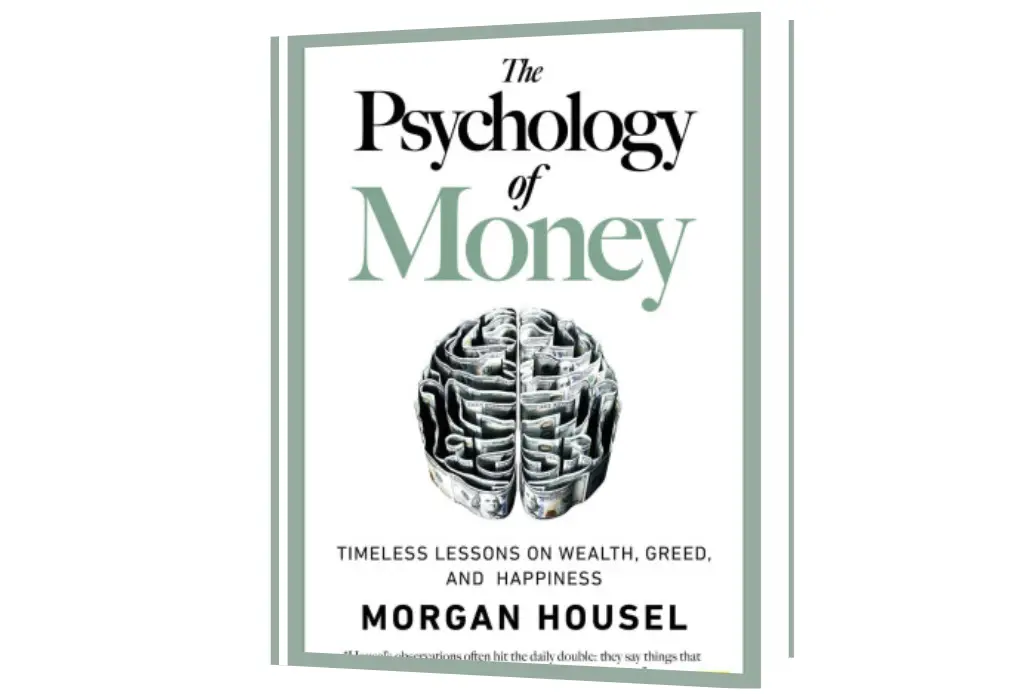Doing well with money isn’t necessarily about what you know. It’s about how you behave. And behavior is hard to teach, even to really smart people. Money―investing, personal finance, and business decisions―is typically taught as a math-based field, where data and formulas tell us exactly what to do. But in the real world people don’t make financial decisions on a spreadsheet. They make them at the dinner table, or in a meeting room, where personal history, your own unique view of the world, ego, pride, marketing, and odd incentives are scrambled together. In The Psychology of Money , award-winning author Morgan Housel shares 19 short stories exploring the strange ways people think about money and teaches you how to make better sense of one of life’s most important topics.
Summary
Chapter 1: No One’s Crazy
Housel begins by asserting that everyone’s approach to money is shaped by their personal experiences, which are unique and subjective. What may seem irrational to one person may be perfectly logical to another, given their background. The chapter highlights the diversity in financial behavior, driven by individual histories and circumstances. For example, someone who grew up during the Great Depression might view money with extreme caution, while someone who experienced a booming economy might be more optimistic and risk-taking.
Chapter 2: Luck & Risk
This chapter delves into the roles of luck and risk in financial success and failure. Housel emphasizes that outcomes are often more random than they appear. Successful people might have been lucky, and those who failed might have faced unavoidable risks. He cautions against equating success solely with skill and failure with incompetence. By recognizing the influence of luck and risk, one can approach money with humility and a better understanding of the uncertainty inherent in financial decisions.
Chapter 3: Never Enough
Housel explores the dangers of not recognizing when one has “enough.” He recounts stories of individuals who amassed great wealth but fell victim to greed, ultimately leading to their downfall. The chapter underscores the importance of contentment and knowing when to stop pushing for more. It argues that chasing after endless wealth often leads to poor decision-making and dissatisfaction. Housel suggests that setting personal limits and recognizing what truly matters can prevent one from falling into the trap of endless pursuit.
Chapter 4: Confounding Compounding
The power of compounding is a central theme in personal finance, and Housel elaborates on this concept by showing how small, consistent gains can lead to significant wealth over time. He uses the example of Warren Buffett, who became one of the richest people in the world not just because of his investment acumen, but because he started investing at a young age and allowed compounding to work its magic over decades. The chapter encourages readers to be patient and focus on long-term growth, rather than seeking quick returns.
Chapter 5: Getting Wealthy vs. Staying Wealthy
Housel differentiates between the skills required to get wealthy and those needed to stay wealthy. While getting wealthy might involve taking risks, being audacious, and making bold moves, staying wealthy requires conservatism, humility, and the ability to avoid big mistakes. The chapter stresses the importance of preserving wealth through caution and understanding that the game changes once you’ve achieved financial success. Maintaining wealth often requires a shift in mindset from aggressive growth to prudent management.
Chapter 6: Tails, You Win
This chapter introduces the concept of tail events—outlier occurrences that have a disproportionately large impact on outcomes. Housel explains that in finance, many successful outcomes are the result of a small number of significant events or decisions. For instance, a handful of successful investments can drive the majority of one’s wealth. The chapter encourages embracing uncertainty and being prepared for the unexpected, as these tail events are often unpredictable but critical to financial success.
Chapter 7: Freedom
Housel discusses the idea of money as a means to achieve freedom—freedom to live life on one’s own terms, to make choices without being constrained by financial limitations. He argues that the ultimate goal of accumulating wealth should be to gain control over one’s time and life. This chapter resonates with the notion that money should be a tool to enhance personal well-being, rather than just a measure of success or power. The freedom that money can provide, in terms of time and choices, is framed as one of the most valuable aspects of wealth.
Chapter 8: Man in the Car Paradox
In this chapter, Housel explores the concept of social comparison and the “Man in the Car Paradox,” where people desire wealth to gain admiration from others, but often, the things they buy to impress others don’t actually attract the admiration they seek. Instead, people tend to focus on their own desires and insecurities rather than truly appreciating what others have. Housel argues that understanding this paradox can help individuals make more fulfilling financial choices, focusing on what genuinely matters to them rather than on impressing others.
Chapter 9: Wealth is What You Don’t See
Housel emphasizes that wealth is often invisible. The expensive things that people buy—cars, houses, clothes—are not indicators of wealth, but rather of spending. True wealth is what you don’t see: the financial assets, savings, and investments that provide security and freedom. The chapter encourages readers to rethink their approach to money, prioritizing savings and investments over conspicuous consumption. Housel suggests that being wealthy is about having the resources to sustain your lifestyle and future, not just about appearing rich.
Chapter 10: Save Money
This chapter focuses on the importance of saving money, not just as a means to an end, but as a strategy to build flexibility, freedom, and peace of mind. Housel argues that saving is often undervalued, with more emphasis placed on earning and investing. He advises that saving should be a consistent habit, regardless of income level, because it builds resilience and provides options in the face of uncertainty. Saving is framed as a powerful tool for financial security and independence.
Chapter 11: Reasonable > Rational
Housel discusses the difference between being rational and being reasonable. While rationality involves making decisions based solely on logic and data, being reasonable considers the emotional and psychological aspects of decision-making. Housel argues that reasonable decisions are more sustainable in the long term because they align with personal values, emotions, and life circumstances. The chapter encourages readers to make financial decisions that they can stick with, rather than those that might be theoretically optimal but practically difficult to maintain.
Chapter 12: Surprise!
This chapter examines the role of unpredictability in financial markets and life. Housel argues that the future is always uncertain, and surprises are inevitable. He suggests that instead of trying to predict the future, one should build a financial plan that is resilient to surprises. This includes diversifying investments, maintaining a margin of safety, and being prepared for the unexpected. Housel emphasizes the importance of adaptability and the ability to respond to changing circumstances, rather than relying on precise predictions.
Chapter 13: Room for Error
Housel introduces the concept of having a margin of safety in financial planning. This means allowing for the possibility that things won’t go as planned and ensuring that your financial situation can withstand unexpected events. The chapter underscores the importance of being conservative in financial projections, avoiding overconfidence, and leaving room for error in decision-making. This approach helps to mitigate risks and ensures that one’s financial goals are still achievable even if things don’t go perfectly.
Chapter 14: You’ll Change
In this chapter, Housel discusses the inevitability of change in personal values, goals, and circumstances over time. He argues that financial plans should be flexible and adaptable to accommodate these changes. What seems important or desirable at one stage of life may not be the same later on, so it’s crucial to build a financial strategy that can evolve. Housel encourages readers to regularly reassess their goals and adjust their plans accordingly, rather than sticking rigidly to a path that no longer aligns with their values or needs.
Chapter 15: Nothing’s Free
Housel explains that everything in life, including wealth, comes with a cost, often in the form of stress, uncertainty, or risk. He argues that recognizing and accepting these costs is essential for making informed decisions. The chapter emphasizes the importance of understanding the trade-offs involved in financial decisions and being willing to pay the price for the benefits you seek. Housel suggests that by acknowledging these costs upfront, individuals can make more conscious choices and avoid the pitfalls of regret or unrealistic expectations.
Chapter 16: You & Me
This chapter explores the differences in financial behavior between individuals and how these differences are often shaped by personal circumstances, values, and life stages. Housel argues that it’s important to recognize that what works for one person may not work for another. Financial advice is not one-size-fits-all, and each person needs to tailor their approach to their own situation. The chapter encourages readers to focus on their own goals and needs, rather than comparing themselves to others or following generic advice.
Chapter 17: The Seduction of Pessimism
Housel discusses why pessimism often seems more compelling than optimism, particularly in financial markets. He argues that while bad news and negative forecasts grab attention, they often overlook the long-term trends of growth and improvement. The chapter encourages readers to maintain a balanced perspective, recognizing that while challenges and downturns are inevitable, progress and growth are also persistent. Housel suggests that optimism, tempered with realism, is a more productive approach to financial planning.
Chapter 18: When You’ll Believe Anything
This chapter examines the human tendency to believe in narratives, particularly those that confirm our existing beliefs or desires. Housel warns against the dangers of confirmation bias and the appeal of compelling but flawed financial narratives. He argues that it’s important to question assumptions, seek out diverse perspectives, and remain skeptical of too-good-to-be-true stories. The chapter emphasizes the value of critical thinking and the need to be cautious of persuasive but unfounded financial advice.
Chapter 19: All Together Now
In this chapter, Housel summarizes the key lessons of the book, emphasizing the importance of a holistic approach to financial management. He encourages readers to integrate the various concepts discussed—such as the power of compounding, the importance of saving, the role of luck, and the need for adaptability—into a cohesive financial strategy. The chapter serves as a reminder that successful financial management is not about mastering any single







